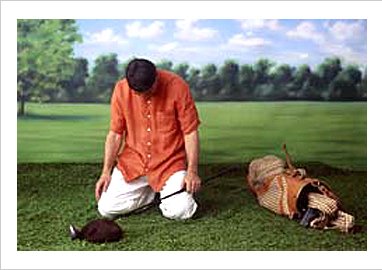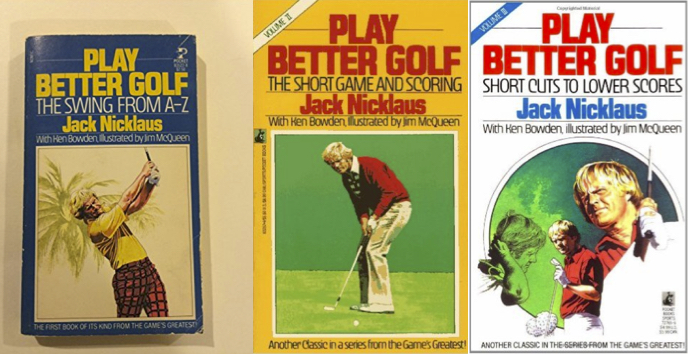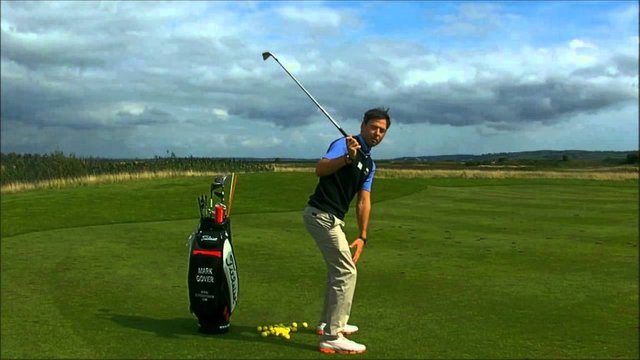How to Lower Your Handicap – Fast!
(my only promise is that you will likely become a better golfer by following what I did to improve my game)
Most of you can probably identify with my quest to become a better golfer (it’s a typical story of trial and error)…
I should have learned from my prior experience when I bought a pair of snow skis. You may ask…
What do skis and golf clubs have in common?
Well…

When in college, some of my fraternity brothers and I took off winter quarter from the University of Georgia to head out to Lake Tahoe for jobs and skiing. The ski shop attendant saw the newbie skier come in and immediately headed me to what I am now sure were the dustiest skis in the shop. Who was I to argue with the expert?
I am now convinced they were made for downhill racers or ski jumpers. I now know that shorter skis are much easier for beginners, but noooo…my new skis were as long as surfboards. Impossible to make cuts or to stop, especially for a beginner. I never became a decent skier because of having the wrong equipment.
Improper equipment = poor results.
I didn’t learn my lesson though, continue on the see how I got screwed again…
Way back when, I decided I was going to become a golfer. After all, all dentists played golf on Wednesday afternoons and Saturdays! I was heading off to dental school and so it was required that I get up to speed so I could join my colleagues on the course twice a week. I became a decent golfer, but that took many years, lots of trials, lots of frustration. So, here’s my story of how I got to where I am today…
My goal is to shorten your learning curve, helping you to avoid some of the mistakes I made on my journey.
I had no idea where to start, but I knew that I needed clubs, a bag, balls, shoes, tees and a glove.
My first purchase was my first mistake. The shop I bought my first set of clubs from had a golf shop adviser that saw a sucker coming, just like the ski shop guy. The sales guy knew I was a newcomer to golf. He extolled all of the virtues and benefits of this “awesome” set of brand new Wilson clubs. He told me that the stiffest shafts were the best for a beginner and that shorter clubs are easier to control.
I fell for his recommendations. I believed everything he said. Who was I to argue? The shafts were so stiff that every shot hurt my hands even when making perfect contact. Also, I had to bend over WAY too far to ground the clubs as short as they were.
That dude must have had a set of clubs he couldn’t get rid of, so he unloaded them on an unsuspecting 23 year old. My game was pretty terrible until…
I met Marvin…
The golf pro at my local club, Marvin McClain, told me to throw away those clubs of mine or to sell them to a very short professional. He let me borrow his clubs for a practice session. They didn’t make an immediate difference though. I had become so accustomed to the short, stiff clubs and bending over way too far just to make contact. I had developed a really weird swing in order to keep from slicing the ball every time I hit the ball.
I bought the proper set of clubs from the pro shop. The clubs were custom fit to my height, level of expertise and my strength. The grips were customized as well. Awesome!

But, it actually took all summer to straighten my swing out. But it finally came together and the rest is history.
Well, not so fast…
I did enjoy a great year of playing golf with my new clubs and improved swing, until…
I started dental school that following year, then entered a residency in Boston immediately after. That amounted to a 6 year layoff (no time to play much golf).
I did play a handful of times with my Dad and his golfing buddies during summer breaks. What a nightmare. The first tee – I whiffed the first attempt at a drive. The next try, I did make contact, but the ball shot straight in front of me, defying physics. It hit one of the burglar bars protecting one of the clubhouse windows. No broken windows!
Get the picture…there were 3 benches under a huge oak tree where all of the seasoned citizen members of the club sat and watched golfers teeing off the 1st tee and approaching and finishing out on the 18th. Every eye was on me. I could hear the snickers, but I was not about to turn toward these men to see their reactions.
If I could have crawled into a hole, I would have.

Needless to say, I wasn’t invited back to that foursome. I didn’t want to embarrass my Dad either, so no more rounds with him and his buds.
Once my residency ended, I settled in and joined a local club and got back to the golf course. Well, Pro McClain didn’t live in my new town, so I went back to the drawing board. I thought I could get my groove back alone. Hmmm…not so fast!
I played for about 2 years twice a week. Frustration was the word of the day. I didn’t improve at all! I contributed to raising the level of all the course lakes due to all of the balls I landed in them. Wildlife in the woods was also endangered – I had a killer slice, so all of the animals stayed in the woods on the left :)
Back to the local Pro for some lessons again. He got my swing back in order after about 3 months of twice a week sessions. I also read books and practiced on my own. At the time, there was no internet to find training materials.
Then, I stumbled upon the most helpful book I ever read.

One of the most helpful books I ever read was by Jack Nicklaus, “Play Better Golf,” published in 1980. On a trip to the beach, the book was on the bookshelf of the condo I was staying in. The instructions and illustrations in this book taught me how to use my lower body and to coil and uncoil for maximum power. I would read a paragraph, then pick up a club and act it out over and over. Then taking what I learned to the practice range and finally to the course has made me a much better golfer than any one thing I know of.
Coaching is required to stay on top of the game

I am living proof that going it alone does not make a better golfer. Even the most accomplished golfer has a coach and practices relentlessly. I have studied as many books and videos as I can find, trying to improve my game. There are tons of materials available to study that can help take your game to the next level. It is also helpful to have another set of eyes on your swing to find your flaws. You local Pro is there for you. That’s his job, so take advantage.
Finding the best set of clubs for me doesn’t mean they are the best for you. Get advice from your local Pro or a reputable golf shop sales person. There are so many variables that “one size does not fit all.”
Steel shaft vs, graphite, stiff vs. flexible shafts, hybrids vs. traditional, Nike vs. Callaway vs. Ping vs. TaylorMade vs. Titleist vs. Cleveland vs. others, club head loft and on and on. So many choices, so many decisions. My advice…get help! This is an big investment in both money and in satisfaction in your play on the course, so choose wisely.
I found a great outline of how to lower your handicap by following recommendations from Golf Digest magazine, arguably the most respected golfing magazine.
“9 Ways To Lower Your Handicap This Year – Golf Digest
- Go To The Range
And keep going to the range. It’s not enough to play as many rounds as you can. Hitting balls at the range helps to groove a repetitive swing (hopefully, not a bad one) and will keep the number of “I haven’t played this poorly in years!” rounds down. So go to the range early and often.
- Practice Your Short Game, Too
When was the last time you practiced your short game? You know, really practiced beyond just rolling a few putts before teeing off on No. 1? This year, pick a putting drill and commit to practicing it before or after every round for 15 minutes. And really work on those four-footers. Columbia professor Mark Broadie writes that a 90-golfer makes 84 percent of his/her three-footers (a scratch golfer makes 93 percent), but just 65% from four feet, while a scratch golfer converts 80 percent. Those putts just outside the gimme range can add up quickly.
- Check Your Equipment
Do you play a driver that Ben Hogan used to endorse? Are the grooves on your wedges so worn down you can’t see them anymore? Do your grips disintegrate in your hands? Then it’s time for an upgrade. Oh, and while you’re at it, get fitted for clubs. Regardless of your skill level, having equipment that fits your body and swing can make a huge difference. In our 2013 case study, eight out of nine players (ranging from single digit handicappers to guys that shoot in the 90s) gained 1.7 strokes after getting fit. Off the tee, the average yardage gain was 21 yards.
- Take Fitness Seriously
Oh, you do 30 seconds of stretching before you tee off? Good for you! That’s not enough. Check that, that’s not nearly enough. A full daily stretching routine will do wonders for your flexibility (a winter of sitting at your desk hasn’t done your swing any favors) as well as help prevent injuries that could end up shortening your season. And don’t stop with stretching. Golf Digest fitness guru Ben Shear says golfers should work on core strength. And if you’re building strength, you’re helping to add distance. In Mark Broadie’s book, “Every Shot Counts,” he says a 90-golfer is 70 yards shorter on average than a pro golfer, leaving the less-skilled golfer a longer approach. From 100-150 yards out, that golfer will hi the green nearly half the time, but from 150-200 yards, that drops to just 26 percent.
- Play In Less-Than-Ideal Conditions
After an especially brutal winter, many courses won’t be in top shape for a while. That doesn’t mean you shouldn’t play on temp tees and greens, though. Practice is practice, and the sooner you get outside walking and swinging, the sooner you’ll find your “mid-season” form. And don’t be afraid to play in the rain/cold/heat/etc., either. It will make those times you find yourself stuck playing in bad weather (hey, it happens) a lot more bearable and make you a lot more likely to avoid carding bad scores that will inflate your handicap.
- Play By Yourself
Sure, you look forward to your weekly game, but getting out by yourself — even if just for a few holes — is fun too. It’s also a great way to practice. With no one else around, playing multiple golf balls on the same hole, can be very useful, especially for figuring out how far you actually hit all of your clubs. Get a range finder to get accurate yardages so you can stop throwing away shots by coming up short on well-struck iron shots. Just be prepared to lose a few more balls than usual — and don’t hold up anyone behind you while looking for those balls.
- Play Different Courses
We’re not saying to abandon your home course, but branching out when given the opportunity will help your golf game. Golf is about making adjustments so playing the same course over and over can lead to a golfer getting too comfortable and usually skew a player’s handicap down since the familiarity with a course makes shooting lower scores easier. Yes, the goal is to lower your handicap, but you also don’t want it to be inaccurate. Challenge yourself by playing different tracks that feature faster greens or more hazards and you’ll improve your all-around skills. Plus, you’ll make your rounds feel more fresh.
- Keep Track Of Your Stats
Knowing your score is nice, but knowing how you got to that score is even better. Did you “play better than your score”? Then prove it. Keep track of your fairways hit, your greens in regulation, your putts per hole, and where you miss fairways and greens to start. Want to go deeper? Download an app that will give you detailed feedback on every shot you hit. That kind of information can tell you what you need to work on most. You know, for when you go to the range.
- Maintain An Actual Handicap
Stop saying you “used to be a 15” or labeling yourself a “90s/80s/etc. golfer.” That’s too vague. Having a Golf Digest handicap will immediately give you a better gauge of what level golfer you are. Not only will it keep track of your scores, but it will factor in the different golf courses on which they came. More importantly, having an official handicap it will allow you to monitor how much you’re (hopefully) improving and let you compete with players who are better than you. Keep up the good work and you might also need a calculator to keep track of all your new-found Nassau profits.”
Read the above article from “Golf Digest” At: http://bit.ly/2rFOz6a
So that’s the end of my journey, so if you want to know some of the references and sources I have either tried or have found interesting, keep reading. The following list of recommendations, methods, training info and equipment may help reduce your learning curve and get you competitive lots faster than it took me.
(Question referred to at that beginning: Am I right handed or left handed?)
I'm not a golfer, but after this article, I could probably play better than some of my friends haha.
Downvoting a post can decrease pending rewards and make it less visible. Common reasons:
Submit
Great post David!
Downvoting a post can decrease pending rewards and make it less visible. Common reasons:
Submit
Congratulations @dallison! You have completed some achievement on Steemit and have been rewarded with new badge(s) :
Click on any badge to view your own Board of Honnor on SteemitBoard.
For more information about SteemitBoard, click here
If you no longer want to receive notifications, reply to this comment with the word
STOPIf you want to support the SteemitBoard project, your upvote for this notification is welcome!
Downvoting a post can decrease pending rewards and make it less visible. Common reasons:
Submit
Congratulations @dallison! You received a personal award!
You can view your badges on your Steem Board and compare to others on the Steem Ranking
Vote for @Steemitboard as a witness to get one more award and increased upvotes!
Downvoting a post can decrease pending rewards and make it less visible. Common reasons:
Submit